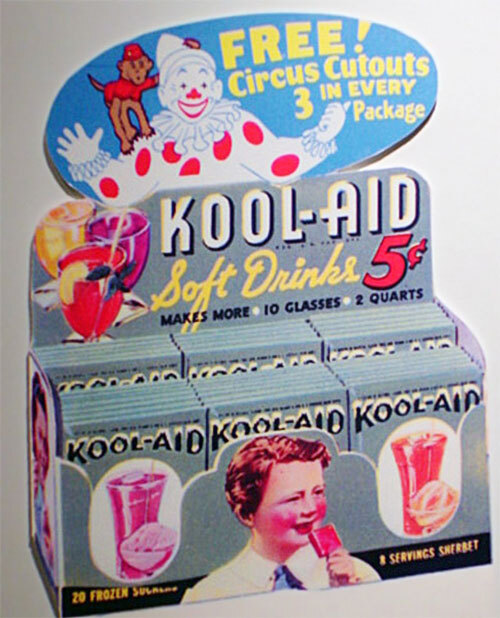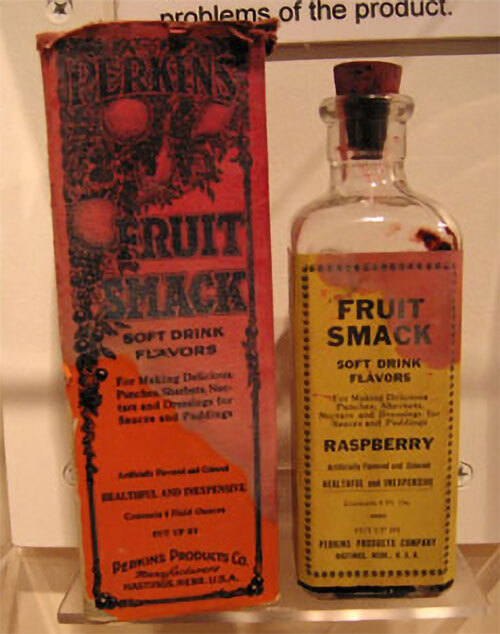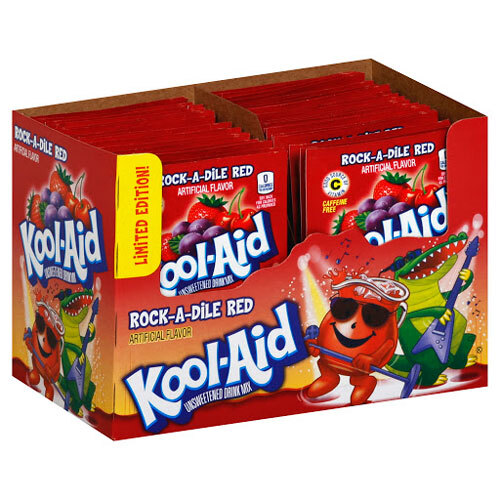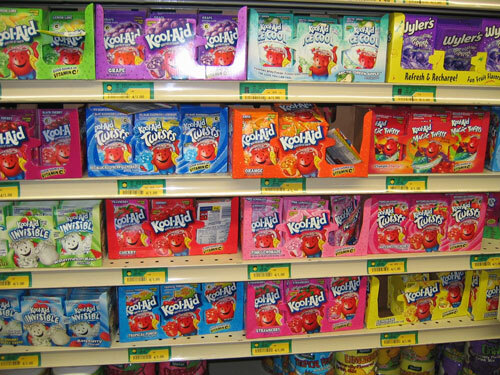Hey all, Ernie here with another great piece from David Buck. He’s been doing some experiments with powdered drink mix, I hear.
Today in Tedium: We can all use a cold sugary drink once in a while. Nothing is better than a cool, refreshing soft drink during the hot summer months. As a kid, we would always drink plenty of tropical punch or cherry kool-aid during the summer ourselves. Following the recent re-release of my two favorite retired flavors—Rock-a-Dile Red and Purplesaurus Rex—I started drinking the sugary beverage again. Kool-Aid is unique for a beverage mix from a pop culture perspective. Take abundant amounts of sugar, a bit of nostalgia, instantly recognizable advertising, a history of retired flavors and a bizarre collector’s market and you’ve got a familiar, fun drink that nearly everyone loved at one time or another. In the past, we’ve brought you the advertising histories of Motel 6, Reese’s peanut butter cups and 7-Up and in today’s Tedium, we’re diving deeper into the bizarre history of everyone’s favorite summer beverage: Kool-Aid. — David @ Tedium
Keep Us Moving! Tedium takes a lot of time to work on and snark wise about. If you want to help us out, we have a Patreon page where you can donate. Keep the issues coming!
We accept advertising, too! Check out this page to learn more.
563M
The amount of Kool-Aid (in gallons) consumed each year in the United States, approximately half of which is sold during the summer months. According to Weird Facts, that comes out to around 17 gallons consumed every second during the three months of summer. In addition to maintaining its popularity through the decades, Kool-Aid has made its way into everything from Kool-Aid Freeze Pops to home-made Kool-Aid brined pickles and beyond. Not bad for a drink that’s nearly a century old!

What Kool-Aid looked like before the Kool-Aid Man took over. (via Nebraska Studies)
How a young entrepreneur used his DIY skills to develop Kool-Aid
The story of Kool-Aid begins with another hyphenated product: Jell-O. Edwin Perkins—whose father owned a general store in Hastings, Nebraska—was fascinated with Jell-O. He persuaded his father to sell it at their general store and later began selling products directly to customers. Eventually he began manufacturing his own homemade products including perfumes, food flavoring and a bottled beverage he called Fruit Smack. Forming his own sales company and selling his products door-to-door, Perkins began bringing some of his concoctions to the general public. A spirit of DIY and interest in developing products led him to create the precursor to his most famous invention.

(via Nebraska Studies)
Before it was developed by Perkins in 1927, Kool-Aid was preceded by a fruit-based liquid called Fruit Smack. It was a liquid concentrate available in a few different flavors. Corked and sold in four ounce glass bottles, the product tended to leak or break during transit. Despite Perkins’ intentions of enabling families to use the concentrate to make pitchers of the beverage for a very low cost, he was confronted with a bit of a supply chain problem. Fruit Smack was a hit with the Perkins’ customers, but its fragility created the need for something more economical, easier to transport and preferably in powdered form. Per curator Teresa Kreutzer-Hodson of the Hastings Museum of Natural and Cultural History:
Fruit Smack was the most popular product in the Perkins line, but its handling and shipping caused problems. The glass bottles were too heavy, too easily broken, and leaked when transported. By 1927, Perkins had developed a method of removing the liquid from Fruit Smack so the remaining powder could be packaged in envelopes (which he designed and printed himself) with a new name, Kool-Ade (later Kool-Aid).
To create his superior drink, Perkins focused on dehydrating Fruit Smack using the proper mix of dextrose, citric acid, tartaric acid, flavoring and food coloring. The rest is sugary beverage history. When Perkins’ original Kool-Aid first hit the market, it had a paltry six flavors—orange, cherry, raspberry, grape, strawberry and the ever popular lemon-lime combo—and it only cost ten cents per packet!
It was originally a wholesale product only available to grocery stores or specialty candy shops. A few years later in 1929, Kool-Aid distribution expanded all over the country, eventually making its way overseas a few years later. Perkins’ operation relocated to Chicago and the Kool-Aid name was officially trademarked in 1934.
5¢
The cost of a Kool-Aid packet during The Great Depression. When hard times afflicted the American public, Perkins decided to halve the price to provide a luxury item to people who otherwise may not have been able to afford it. It ended up becoming one of Perkins’ most successful products and he later sold the brand to General Foods in 1953. A packet of Kool-Aid at most stores near me only costs about $.20 today, which is still incredibly affordable—unless you’re trying to buy certain discontinued flavors online, which can get a bit pricey.

Rock-a-Dile Red, one of the most popular flavors that has been discontinued in the past.
The strange case of the Kool-Aid collector’s market
Over the years, Kool-Aid has released around 74 different flavors. Despite its popularity, a large quantity of these flavors of Kool-Aid have come and gone over the years. Some of the most popular flavors—Great Bluedini, Rock-a-Dile Red, Purplesaurus Rex, Pink Swimmingo, Incrediberry, Sharkleberry Fin and Berry Blue—have been retired over the years.
A few have made a return to store shelves, but for the most part some of these flavors can only be found on secondary markets. Luckily, there is a secondary marketplace for fans of discontinued flavors—not to mention plenty of collectors around! Sites like Kool-Aid world provide a few options with the tagline, “Even popular flavors get discontinued. We have limited quantities of these classic flavors, so get them while you can.”
While they’re offerings are rather inexpensive, there is apparently an entire market for collecting old Kool-Aid Packets. As Will Hodge wrote for The Takeout in 2019, the community of Kool-Aid collectors is certainly willing to pay decent amounts for old Kool-Aid packets:
While there’s no real quantifiable way to know just how big this particular community is, the best place to pulse-check their vitality is eBay. A quick search for “Kool-Aid packet” seemed to signal the market is alive and well, returning over 250 active listings, some of which were going for triple-digit asking prices: $400 for a still- sealed case of Pink Swimmingo, $225 for a single packet of Yabba-Dabba-Doo Berry, and $195 for a single packet of one of Kool-Aid’s most beloved flavor mascots, Purplesaurus Rex, just to name a few. A search for recently completed eBay auctions showed a display of 1960s Grape packets being sold for $250 and a single packet of Rock-A-Dile Red closing out at $125. The good stuff don’t come cheap, my friends.

A sampling of some of Kool-Aid’s many flavors. (Gypsyjolie/Flickr)
One prominent collector—Matt from the pop culture website Dinosaur Dracula—features Kool-Aid nostalgia and occasional taste tests of discontinued flavors from his collection on his site. If you ever wondered what “Bedrock Orange” or “Rainbow Punch” tasted like, Matt’s delightful descriptions can give you a good idea with a little bit of humor on the side. When it comes to collecting, however, Matt asserts the primary reason for collecting is probably nostalgia and a love for the brand’s myriad mascots, telling The Takeout:
“My interest in Kool-Aid is on the extreme side. But what I’ve found through covering it is that Kool-Aid seems to make everyone happy. Whether it reminds them of some long-ago family picnic or using the stuff to badly dye their hair in high school, it weirdly connects to so many personal memories. It’s kind of a mutant version of Proust’s madeleines.”
Then there’s the question of whether it’s safe to drink. We certainly don’t recommend consuming expired food or beverages. But aside from the obvious risks involved with consuming expired food, this is clearly a subject of interest for collectors and non-collectors alike given a sampling of the question being asked/answered on Quora.), Rhett & Link’s Ear Biscuits and all over Reddit.
Of course, you could always make your own Purplesaurus Rex by mixing a packet of grape and lemonade Kool-Aid flavors together to capture that sweet, tart nostalgic flavor.
1975
The year the Kool-Aid man as we know him was introduced to the world through the Grey Advertising Agency. Developed by Alan Kupchick and Harold Karp, the concept was intended to give a more bombastic personality and make him larger than life. Most of us are familiar with the series of commercials where a giant bipedal pitcher of presumably tropical punch Kool-Aid violently breaks through a wall and yells “Oh Yeah!” The character was originally voiced by Grey Agency composer Richard Berg with renowned voice over artist Frank Simms taking over the role until 2015 (Brock Powell is the current voice of the character). With a Q-score of 26, his iconic look and his hilarious signature catchphrase, Kool-Aid Man is instantly recognizable as part of the Pop Culture Pantheon. He even starred in his own Atari 2600 and Intellivision games and a short-lived comic book series, which is pretty good for a mascot—even if Time Magazine thinks he’s creepy.
A Breakthrough Campaign: the strange pop culture legacy of Kool-Aid advertising
Oddly enough, Kool-Aid infiltrated pop culture right from the start. The original mascot was simply a pitcher of kool-aid with a smiley face called “Pitcher Man,” inspired by a drawing one advertising executive’s son made on a frosted window. Advertising included the original pitcher-with-a-face character, Looney Tunes characters like Bugs Bunny and there was that time the Monkees and Bugs Bunny starred together in a series of hilarious Kool-Aid commercials.
When the Grey Agency created the anthropomorphic version of the character in 1975, the idea was to create a hip character with broad appeal. The executive behind Kool-Aid Man at the time told Mental Floss in 2017 about how they came up with the mascot’s iconic entrance move:
The iconic breaking-through-the-wall sequence wasn’t necessarily planned. From what I’ve heard, someone on set said that Kool-Aid Man really had to make an entrance, and someone else, maybe a producer, suggested he come through the wall. Breakaway bricks were set up, and the character’s fiberglass shell—the same material used for a Corvette Stingray effectively became a wrecking ball.
The entire concept of the commercials revolved around the adults looking goofy while the kids and Kool-Aid Man saved the day. Many of the ideas were inspired by Skoller’s kids and proved quite popular.
One Kool-Aid Man commercial features the pitcher bursting into a bowling alley while singing a jingle about the beverage, with a serious Dr. Hook vibe to the vocal. Later commercials became increasingly wacky and hilarious leading to the brand longevity and stability the character enjoys today. In the 80s and 90s, the stories became more of a constant flow of images and techniques rather than a storyline. According to Advertising Week 360:
Each thirty-second spot combined live action and CGI together. Along with tricky compositing, editing, and music mixing, making Kool-Aid ads required an incredible amount of time and hard work.
As tastes and competition evolved, so did Kool-Aid Man. But unlike some advertising mascots who disappear after a while or are significantly altered, Kool-aid Man is more or less the same character (with the same basic design) he’s always been. He received a CGI upgrade around 2013 and continues to delight Kool-Aid fans young and old to this day. He’s been lovingly parodied all over pop culture including several times on the popular adult cartoons Family Guy and Robot Chicken.
On top of their magnificent advertising campaigns, Kool-Aid ran a points redemption program called The Kool-Aid Vault and later, The Wacky Warehouse. Every Kool-Aid product had points you could clip and collect. Then, you’d send the points off to get various items like plush toys, Kool-Aid pitchers, T-shirts, toys, comics and more.
Kool-Aid points could be redeemed for any number of items that would appeal to the general interests of the beverage’s core market: kids. Collecting the points was a fun activity that made superb Kool-Aid swag available to fans of the beverage. Friend of Tedium, Weird Paul Petroskey still has many of the items he got from saving his Kool-Aid points during the ’80s, as he outlined in a 2017 vlog:
The program ended in 2007, although points could still be redeemed until 2010. Long gone are the days when one could snag the Atari 2600 version of Kool-Aid Man or get a copy of Mario Paint by redeeming Kool-Aid points. Nostalgia is actually baked into modern Kool-Aid advertisements—the official website (circa 2011) marketed the envelopes of unsweetened powder as “a sweet flashback to childhood.”
50
The number of fans the Kool-Aid Man character invited to participate in a celebratory video for Kool-Aid Day on August 9, 2019. Using Cameo to get celebrities like Flavor Flav, Raven-Symone, Sisqo, Ryan Cabrera and Ginger Minj to sing his catchphrase along with him, the Kool-Aid Man created a music video to mark the event. Kool-Aid seems to have left a mark on the music world in a few bizarre ways. Aside from the 1950s Kool-Aid jingle celebrating how “a five-cent package makes two quarts” with the promise of “nine great flavors” and the commitment of being “the very best drink you ever made,” surprisingly few songs inspired by Kool-Aid have much or anything to do with the drink itself. There was Johnny Paycheck’s country tune “Colorado Kool-Aid” that had absolutely nothing to do with the drink whatsoever. The song tells the story of a rather nasty bar fight framed around the singer drinking the titular beverage—“a can of Coors brewed in a fresh mountain stream.” A more recent Christmas song by Lil John features Kool-Aid Man prominently in both song and video. Bowling for Soup even got in on the fun with their song simply called “Kool-Aid” (even though it has nothing to do with Kool-Aid).
As it approaches the century mark, Kool-Aid remains popular with no signs of slowing down. Now owned by Kraft Foods, the brand is expanding into new flavors once again while continuing to inspire DIY projects using the product. I don’t know if I’d clean my washing machine or toilet with a packet of Kool-Aid powder, but it makes a great hair or T-shirt dye and is surprisingly versatile for a packet of unsweetened fruit-flavored powder.
The internet provides boundless interesting ideas for making your own Kool-Aid—including a Metafilter user who uses the unsweetened powder as flavoring for home-made marshmallows—and Instructables has an entire recipe for making Kool-Aid with Jell-O. Edwin Perkins would be proud to see his DIY spirit and enthusiasm for powdered, fruit-flavored treats living on in today’s tumultuous world.
Purplesaurus Rex and Rock-a-Dile Red have returned a few times before, but Pink Swimmingo is sadly nowhere in sight. What will the future hold for Kool-Aid? Will we see more retro flavors make a comeback? We hope so, but for now I’ll be in the kitchen mixing up the next batch of my favorite non-coffee beverage.
--
Find this one an interesting read? Share it with a pal!
Correction: A prior version of this article left a “M” off a big number, implying that the entire U.S. shared 563 gallons of Kool-Aid each year. That wouldn’t be very much refreshment to go around, would it?





